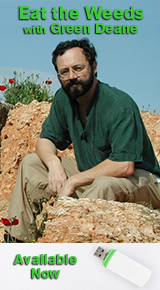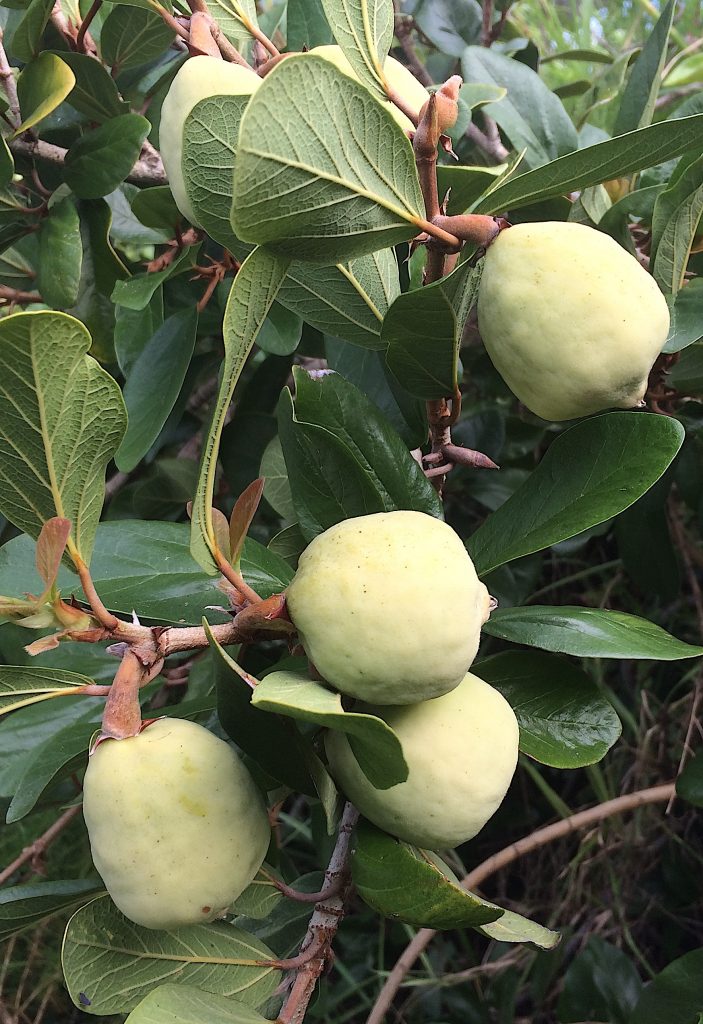
Is it time to take the Creeping Fig out of the edible realm. You can read about it below. Photo by Green Deane
What is it? The answer is barely edible. A decade ago while sipping a beer at an outside bar in Ybor City I saw a prolific vine on a brick wall with what looked like a large green fig. I was reasonably sure it wasn’t a product of the beer so some research was in order. It was a Creeping Fig. The main problem with the species — besides barely making it into the edible realm — is growth pattern. The leaves and vines of the fig when young are very small then at some point the plant transforms itself into a large vine with leaves having little resemblance to what it used to be. Then it produces green fig-like fruit. The fruit basically is not edible. But the expressed juice jelled in water is. That’s a bit strange. To read about it, go here.
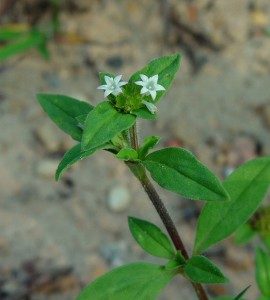
Richardia is generally not edible. Photo by Green Deane
If a plant does not cause acute illness (within minutes or hours) then judging when it might make you ill is difficult to say. It might take months of consumption (or perhaps with something like canned fiddlehead ferns, years.) One of those possible plants is Florida Pursley, aka Richardia scabra. I do know of a couple people who ate a leaf and had no problem. They mistook it for chickweed. I know of someone who ate several leaves at once and had gastrointestinal distress. And the roots are reportedly an emetic. More telling is that we have little information about how if at all it was used by Native Americans. That often is a clue it’s a plant to avoid, at least from a food point of view. If a plant is not in the ethnobotanical literature either the natives didn’t use it, we didn’t ask, or they didn’t tell us. It is best to stick we plants that we know for certain were used for food.
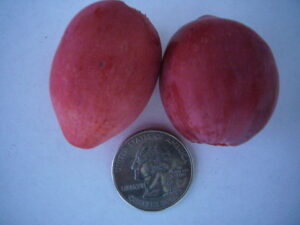
In some places Natal Plums are a commercial fruit. Photo by Green Deane
Natal plums are not plums but they’re a tasty fruit which once established are extremely wind, drought and salt tolerant. This makes sense as the first time I saw them was some 45 years ago at a beach house inside Canaveral National Park in New Smyrna Beach. For $75 we could rent the two-story place from Friday afternoon until Monday morning. It slept six, was almost across the street from “Turtle Mound” and was right on the beach, literally. The best part is we were locked in the park from sunset to sunrise giving us the entire beach to ourselves all they way down to the space center some 30 miles away. That house had a hedge of Natal Plums on the west side. In fact just north of Bethune Beach Park there is a half-mile section of A1A that is residential and on the beach. Many of those houses have Natal Plums and where I go when I want to collect a lot of them.
Some 25 years later when I was in San Diego on business I saw Natal Plums everywhere in both commercial and residential landscaping. They can take the dry heat. And in Port Charlotte, Fla., where I teach some of my foraging classes, there are several Natal Plums in the area. There are some in the neighborhood where I live. Invariably when I ask the owner if I can have the fruit they have no idea they are edible. In fact I find most of the Natal Plums when I’m driving. When I spy a dark green hedge with plum-size red fruit it’s almost always the Natal Plum. Closely related to the deadly Oleander there is a large, commercial variety of the species available. And while various fruit councils have championed the species for decades it never really took off as a commercial fruit. You can read about it here.

Sycamores drop a lot of leaves. Photo By Green Deane
Sugar maples are famous for their syrup but how many species of trees can you actually tap? In North America the answer is at least 22. “Sugaring” was a special time of year in New England when I was a kid. Warm days and near freezing nights in the spring started the sap flowing out of the roots back towards the top of the trees. A tap and a bucket produced pails of mildly sweet sap and a lot of bugs. Hours of boiling reduced that to maple syrup. Have you ever heard of Maple Walnut Ice Cream? It was common in sugaring country. The largest group of trees you can tap are maples ( Sugar, Black, Red, Silver, Norway, Boxelder, Bigleaf, Canyon, Rocky Mountain, and Gorosoe.) The birches can also be tapped (Paper, Yellow, Black, River, Gray, and European White Birch.) If I remember correctly no native group of Europeans ever tapped them for food until they learned of the practice by natives in North America. Trees in the walnut group can also be tapped: Butternut (my mother’s favorite) Black Walnut, Heartnut, and English Walnut. There are two outliers which grow locally. One is Hophornbeam or as I called it while growing up, Ironwood. It also has edible seeds. The other tappable species is a very common native and ornamental: The Sycamore. It takes about four to five times more Sycamore sap to get a gallon of syrup than from a Maple. The biggest surprise is that Sycamore Syrup tastes like butterscotch. Although the sap is excellent for syrup, the wood is horrible for smoking food. Processing a natural plant does not always have the outcome you intend. Sea grapes (which ripen in about September) have a unique taste. Make them into jelly, however, and their originality disappears and they taste like apple jelly. And while birch syrup is a unique, commercial product. It can taste quite similar to molasses, which is far less expensive. You can read about Sycamores here, Ironwood here.
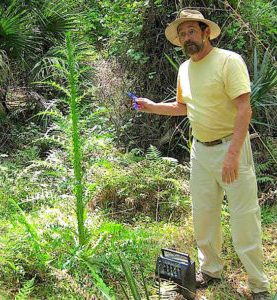
Foraging classes are held rain or shine, heat or cold. Photo by Nermina Krenata
May 31st, Wickham park, 2500 Parkway Drive, Melbourne, FL 32935-2335. Meet at the “dog park” inside the park. 9 a.m. to noon.
June 7th, Mead Garden, 1500 S. Denning Dr., Winter Park, FL 32789. Meet at the bathrooms. 9 a.m. to noon.
Bring cash on the day of class or click here to pay for your class. If cost is a hardship email me at: GreenDeane@gmail.com.

A cluster (not a bunch) of local single-tendril grapes. Photo by Green Deane
Will wild grapes be early this year? The general calendar date for them is September first. In Maine school always started the Tuesday after Labor Day. A couple of weeks later I’d be late for school and home because of grapes and apples. I walked two miles each way and that took me past hedgerows of Concord Grapes. In a couple of weeks apples in the nearby orchard got my attention. Before modern internet slang “scrumping” meant kids stealing local fruit. And that I did though most of these vines and trees were around old farmsteads and not tended. Locally grapes have shown up in August even late July. Here it is late-May and this past week I saw several getting ready-to-ripen clusters on local muscadines. (I was hunting mushrooms at the time but that’s how one often gets a lead on food to come.) These are in the single-tendril group. I suspect the forked-tendril ones will wait until September to ripen. You can watch my video on grapes here and read about them here.

You get the USB, not the key.
All of Green Deane’s videos available for free on You Tube. They do have ads on them so every time you watch a Green Deane video I get a quarter of one cent. Four views, one cent. Not exactly a large money-maker but it helps pays for this newsletter. If you want to see the videos without ads and some in slightly better quality you can order the DVD set. It is nine DVDs with 15 videos on each for a total of 135 videos. Many people want their own copy of the videos or they have a slow service and its easier to order then to watch them on-line. The DVDs make a good gift for that forager you know especially on long, cold winter months. Individual DVDs can also be ordered or you can pick and choose. You can order them by clicking on the button on the top right hand side of this page (if your window is open wide enough.) Or you can go here.

Green Deane Forum
Want to identify a plant? Looking for a foraging reference? Do you have a UFO, an Unidentified Flowering Object you want identified? On the Green Deane Forum we chat about foraging all year. And it’s not just about warm-weather plants or just North American flora. Many nations around the world share common weeds so there’s a lot to talk about. There’s also more than weeds. The reference section has information for foraging around the world. There are also articles on food preservation, and forgotten skills from making bows to fermenting food. One special section is “From the Frightening Mail Bag” where we learn from people who eat first then ask questions later. You can join the forum by clicking on “forum” in the menu.
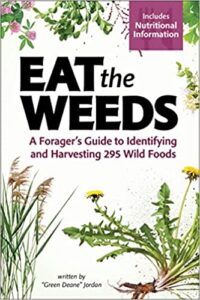
EAT THE WEEDS, the book, 274 plants, 367 pages, index, nutrition charts and color photos. It’s available in many locations including bookstores such as books a million, and Amazon. Most of the entries include a nutritional profile. It can also be ordered through AdventureKeen Publishing. This is weekly newsletter #639 If you want to subscribe to this free newsletter you can find the sign-up form in the menu at the top of the page.
To donate to the Green Deane Newsletter click here.

